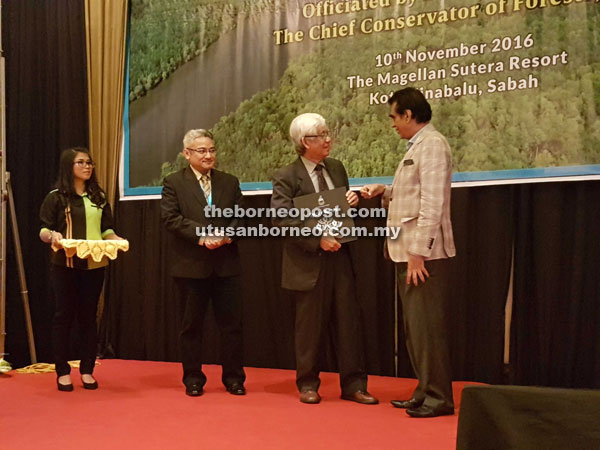
Sam (right) presenting a memento to Dr J. E. Ong, an expert on mangroves and wetlands at the launch of the second Sabah Ramsar Conference 2016 yesterday.
KOTA KINABALU: The Sabah Forestry Department enforcement team is armed due to the constant risks they are facing while carrying out their duties, said its director Datuk Sam Mannan.
He said that among the threats faced by his personnel came from the Philippines.
He said the mangroves on the northern side of Sabah were often raided for the Tangal bark.
“The Tangal bark is of no use in Malaysia but valuable in the Philippines. We have a lot of people who raid our mangrove on the northern side of Sabah,” he said during the launch of the second Sabah Ramsar Conference 2016 yesterday.
Sam said these people were armed and had nothing to lose because if they went back empty handed, their own lives would be in peril.
This was because they borrowed money prior to coming here to collect the bark, he explained.
He added that while his department had tried its best to work with other enforcement agencies, they had to be independent and look after themselves.
“The police provided approvals for 45 guns to the department to allow us to protect the mangroves and wildlife. We have ordered another 50 guns,” he said.
He also said his team had undergone training by the United States in Thailand.
Besides the Tangal bark poachers from the neighbouring country, Sam said the forestry personnel are also protecting the wetlands and Ramsar site on the east coast of Sabah (at the Lower Kinabatangan — Segama Wetlands) which was secluded and still under travel advisory by other countries such as Japan, the US, UK, Australia and New Zealand.
“No insurance will cover you when you go there,” he said.
Meanwhile, Sam said the mangrove forests in Sabah were being rehabilitated.
He said there were now 340,000 hectares of mangroves in Sabah, with 25 percent under Totally Protected status.
He also said mangroves were resilient trees and would grow back after six months — as long as no land reclamation takes place at the area.
“Reclamation (land) will kill the mangroves,” he explained.
Sam also acknowledged that from time to time, they had to take away some mangroves to make way for developments.
Two of such developments are the Pan Borneo Highway and the Semporna township.
